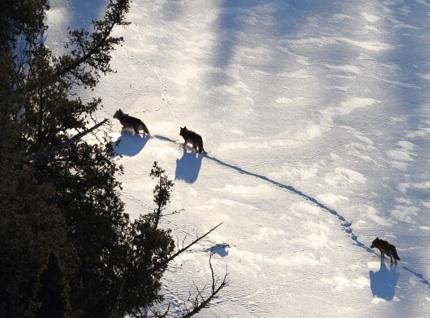
Isle Royale National Park officials are refocusing an EIS to look at the specific question of whether they should transplant wolves to the island to help maintain a pack/Michigan Tech file photo
With just two known wolves left within the confines of Isle Royale National Park in Michigan, park officials are refocusing an environmental impact study to the specific question of whether they should transplant wolves to the island park to help maintain a population of the predators.
Last year the park staff began considering a broad range of management actions to determine how to manage the moose and wolf populations within the park for at least the next 20 years. Following public comments and additional internal deliberations, the the Park Service has now determined that it will narrow the scope of the EIS to "focus on the question of whether to bring wolves to Isle Royale National Park in the near term, and if so, how to do so."
Chronic inbreeding appears to have impacted the health of the wolf population. There was hope that "ice bridges" that formed between the Lake Superior island and the Canadian mainland during the winter of 2013-14 would enable wolves to arrive from Canada with new genes. But no new wolves reached the island, while one female left and was killed by a gunshot wound in February 2014 near Grand Portage National Monument in Minnesota.
Isle Royale wolves have been in decline for more than a decade. In recent years park managers have discussed island and wolf management with wildlife managers and geneticists from across the United States and Canada and have received input during public meetings and from Native American tribes of the area. Those discussions have examined the question of whether wolves should be physically transported to Isle Royale, in large part due to concerns that a loss of the predators would lead to a boom in the moose population that likely would over-browse island vegetation.
"Over the past five years the wolf population on the island has declined steeply," a park release issued Wednesday said. "There were three wolves documented on the island as of March 2015 and recent surveys confirm only two wolves as of February 2016. At this time, natural recovery of the population is unlikely. The potential absence of wolves raises concerns about possible effects to Isle Royale’s current ecosystem, including effects to both the moose population and Isle Royale’s forest/vegetation communities.
Documents outlining the park's new focus can be found on this website. Once the plan is published in the Federal Register, there will be a 30-day public comment period.
“All comments already submitted have been posted online, however, we welcome additional input at this time,” said Superintendent Phyllis Green.
Park staff held public meetings last summer and received thousands of comments from the public and stakeholders. Feedback was received from all 50 states, the District of Columbia, and 19 other countries. Many commenters urged the Park Service to bring new wolves to Isle Royale, according to the park release. Others opposed management of the wolf and moose populations.



Comments
I hope wolvs are (re)introduced to create a type of sanctuary. I love this park; coming across a fresh wolf track--twice--was really great.
My vote is sit back and let mother nature take care of things.
To think that Isle Royale might be wolfless - even though I have never been there and am very unlikely to go - is chilling. Durward Allen's "Wolves of Minong" was a seminal book in my development as a wildlife biologist.
I feel that the Isle Royale Wolves need immediate help. New wolves should have introduced two years ago, when the treat of extinction had first been known.
It is shameful that the parks department is dragging their feet, and these wolves are being allowed to die off! All too often it seems that government turns their backs on wolves. It is time that government and people realize that the fairy tales we heard as children were really fairy tales!
Wolves are essential to the balance of nature, and play an important part in America's wilderness. Every BLOOD LINE is valuable, and must be protected. There should be no discussion as to letting the last two die, before introduction of more wolves, that idea is appalling!
I believe that root of the problem, is the loss of ice bridges, due to "Global Warming", caused by man's disregard to nature, and greed. It is therefore man's responsibility to intervene, NOW, while there are two wolves left.
We must not allow another blood line to vanish, we must do all we can, and take action today!
I wonder if wildlife corridors toward the island (if and when a land bridge were to reform) have been diminished since the wolves first arrived. If so, that would seem to be another reason that justifies, according to NPS policy, the introduction of more wolves to the island.
I remember Durwood Allens research of the wolves there. We still have much to learn about predator prey relationships and the introduction of wolves would perpetuate the unique laboratory situlation that Isle Royal represents.
I believe a few wolves should be introduced to Isle Royale to help increase the population. I recommend relocating wolves from British Columbia where wolf culling is currently taking place by the Canadian government in order to increase the local caribou population. Introduction of new wolves should be done whenever genetic diversity is low within the local population of Isle Royale.